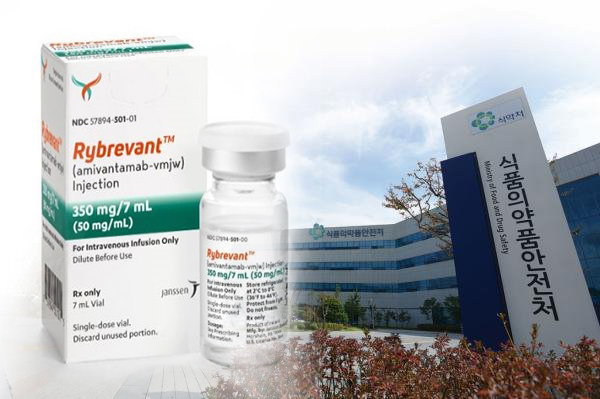Janssen’s Rybrevant (amivantamab), the first therapy for non-small cell lung cancer (NSCLC) patients with epidermal growth factor receptor (EGFR) exon 20 insertion mutations, may obtain marketing approval in Korea, industry sources said.
The Ministry of Food and Drug Safety is reviewing Janssen’s application for Rybrevant approval, they said.
Rybrevant targets both EGFR and MET mutations. Korean researchers have actively participated in Rybrevant development since the early stage.
In May, the U.S. FDA authorized Rybrevant to treat NSCLC patients with EGFR exon 20 insertion mutations whose disease progressed after platinum-based chemotherapy.
NSCLC with exon 20 insertion mutations is the third-most common subtype of EGRF mutation, after exon 19 deletion and exon 21 L858R point substitution.
However, existing EGFR TKIs have shown low response rates of zero to 9 percent in NSCLC with exon 20 insertion mutations.
The platinum-based chemotherapy is still the standard therapy for NSCLC with exon 20 insertion mutations, but the patients’ prognosis is very poor, with only 16 months of overall survival (OS).
Recent real-world data showed that the overall response rate of these patients in the second-line treatment was about 13 percent, and their median progression-free survival (PFS) and OS were only 3.5 months and 12.5 months, respectively.

Pharmaceutical companies around the world are developing therapeutic agents targeting exon 20 insertion mutations. Among candidate drugs, EGFR TKIs mobocertinib and poziotinib are in late-stage development.
However, recent trials' response rate and safety data of mobocertinib and poziotinib were insufficient to meet unmet clinical needs.
Poziotinib demonstrated a 14.8 percent response rate in 115 patients, and 29 percent and 26 percent reported grade 3 higher adverse reactions of rash and diarrhea, respectively.
Mobocertinib showed a 28 percent response rate in 114 patients, and 46 percent had grade 3 or higher adverse events. Ninety percent of the patients reported diarrhea as a treatment-related adverse reaction, and 45 percent reported rash.
Despite such safety profiles, mobocertinib (brand name: Exkivity) won the FDA approval for the second-line treatment of NSCLC with EGFR exon 20 insertion mutations in September.
The authorization was based on an improved response rate compared to existing EGFR TKIs.
Rybrevant showed even more improved data in response rate and safety compared to mobocertinib.
According to the early results of the phase 1 CHRYSALIS study, presented by professor Park Keun-chil of hematology-oncology at Samsung Medical Center in the Journal of Clinical Oncology, Rybrevant showed a 40 percent response rate in 81 patients (including complete response in three patients). The median duration of response (mDoR) was 11.1 months, and the median PFS was 8.3 months.
According to safety profiles reported in 114 patients, the most common grade 3 to 4 adverse events were hypocalcemia (5 percent), rash (4 percent), pulmonary embolism (4 percent), and neutropenia (4 percent). Thirteen percent had a treatment-related dose reduction and 4 percent, treatment discontinuation.
Korean researchers led the trial, and 49 percent of the patients were Asian.
Observers said that as Rybrevant received the U.S. nod quickly with an accelerated review process, the MFDS may speed up the drug evaluation.
Rybrevant is also being developed as a monotherapy and in combination with an EGFR TKI in EGFR-mutated NSCLC. Experimental therapies include the combo of Rybrevant and Yuhan Corp.’s Leclaza (lazertinib).

